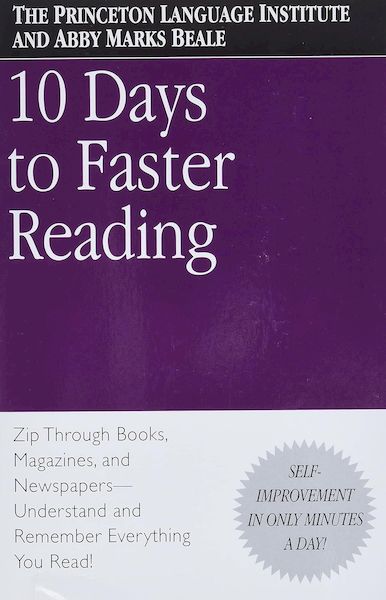Overview of the Book: What are the Benefits for Me? Enhance Your Reading Speed and Improve Your Retention of Information.
If given the chance to make three wishes, many would likely ask for immense wealth and the ability to soar through the skies. However, for avid readers constrained by time, one wish might be dedicated to gaining the capacity to read at an extraordinary pace.
This book summary does not promise superhuman reading abilities, yet achieving quicker and more effective reading skills does not require magical intervention – it involves abandoning unproductive habits and mastering some techniques.
Ten Days to Quicker Reading portrays the process of developing faster reading skills within a ten-day period.
This summary brings together the top methods, suggestions, and illustrations from the book. By immediately practicing these techniques with your daily newspaper or any non-fiction materials at your disposal, you can progress towards becoming a faster reader while retaining more of the content.
In this summary, you’ll discover:
- why our approach to reading is flawed;
- how you can absorb 40 percent of a book’s content without reading it entirely; and
- the consequences of underutilizing your brain’s potential to process information.

- INDIVIDUALS PUT TOO MUCH STRAIN ON THEMSELVES DURING READING SESSIONS
- ENHANCING YOUR EFFICIENCY AS A READER INVOLVES BREAKING A FEW DETRIMENTAL HABITS
- EMBRACE SHORTCUTS TO ENHANCE YOUR READING SPEED
- EXPERIMENT WITH EXCLUSIVELY SCANNING THE CORE TERMS
- IMPLEMENT “READING BETWEEN THE LINES” AND “INDENTING” AS ADDITIONAL STRATEGIES
- UTILIZE YOUR HAND OR A PEN AS GUIDES FOR YOUR EYES, FACILITATING RAPID READING HABITS
- IN REVIEW: 10 DAYS TO SWIFT READING BOOK SUMMARY
INDIVIDUALS PUT TOO MUCH STRAIN ON THEMSELVES DURING READING SESSIONS
The struggle between an excess of reading material and limited time is a common dilemma. Every day, the pool of captivating reading options expands, increasing the backlog of books in your “to-read” list.
The issue is not solely time-related; it stems from ineffective reading methods fueled by prevailing misconceptions about reading.
Primarily, it is unnecessary to read everything within a book or newspaper to grasp its essence. It is practically impossible to read every piece of material that comes across your desk. Instead, the key is to develop a habit of discerning and prioritizing what is truly important. Revisiting this point later, you will find it surprisingly simple once you master techniques to preview content efficiently and identify areas of genuine interest.
Additionally, it is not imperative to retain every detail read to extract value from the content. The tendency to feel obligated to commit every textbook detail to memory originates from the educational environment, where students are pressured to memorize content for upcoming tests.
Nevertheless, memorized facts reside in short-term memory and are swiftly forgotten. To secure information for the future, establishing a convenient retrieval system is essential.
Consider documenting vital information (either digitally or on paper) or annotating and highlighting content in the margins. Subsequently, organize this material for easy retrieval, alleviating the burden of attempting to memorize every piece of information.
Furthermore, there exists a misconception that reading should be avoided during work hours. Contrary to this belief, reading is an integral aspect of your professional responsibilities.
Individuals in business environments might fear being perceived as unproductive if seen reading on the job. However, reading relevant materials can spawn fresh business concepts, keep you informed about industry trends, and equip you to outperform competitors.
Hence, reading at work is not only permissible but crucial!
ENHANCING YOUR EFFICIENCY AS A READER INVOLVES BREAKING A FEW DETRIMENTAL HABITS
Repetition forms habits, whether positive or negative. Similarly, reading habits are shaped by frequent practices. So, what are some common poor reading habits, and how can you overcome them?
One prevalent bad habit is passive daydreaming, where the mind wanders in numerous unrelated directions during reading sessions.
The objective is to modify this unproductive mind-wandering into active mental exploration, a form of thinking that links the read information to personal experiences. This approach facilitates the fusion of existing knowledge with new insights.
Transitioning involves steering thoughts purposefully. For instance, suppose you are perusing an article on Italian art. Enable your thoughts to drift to your previous visit to Italy. This association acts as a mental adhesive for integrating new knowledge.
Another counterproductive habit is regressing, which involves revisiting previously read sections. To avoid this, cover the material you have just read with a card, exposing only the line being read. While regressing often amounts to wasted time, instances where the author’s message is unclear or unfamiliar vocabulary emerges warrant revisiting.
Similarly, many individuals subvocalize while reading, either whispering words mentally or mouthing along with the text. Ordinarily, the brain processes up to 400 words per minute; however, vocalizing while reading limits the reading pace to around 150 words per minute.
Cease subvocalization to enhance reading speed and surpass the 150 words per minute threshold!
When aiming for swift reading and eliminating subvocalization, concentrate on the critical terms and skim over the remaining content. Alternately, engage in muttering, humming, or chewing gum while reading – these audible cues accelerate reading pace.
EMBRACE SHORTCUTS TO ENHANCE YOUR READING SPEED
With awareness of detrimental habits, the pathway to becoming a faster, more efficient reader unravels through three straightforward steps.
Initially, maintain a clear objective and accountable mindset concerning your reading material. This stance aids in organization and focus.
Determine what to peruse and what to skim through by questioning, “Why am I reading this?” For instance, if your goal is to expand knowledge in a specific domain or stay informed on global events, archiving professional articles from two years ago is unnecessary!
Subsequently, ask, “What purpose does this information serve?” It may be for an examination, a meeting, or aiding your child’s academic performance. Yet, if your child excels academically, scrutinizing their assignments daily may not be obligatory.
Prior to delving into any material, pose these pivotal questions; if satisfactory answers elude you, relinquish reading.
Secondly, preview all nonfiction content before commencing a detailed perusal to grasp its essence and identify pertinent sections.
Initiate by scanning the initial paragraphs to fathom the introduction’s direction. Proceed to peruse bolded subheadings, titles, and subtitles. Finally, review the initial sentences of paragraphs to glean insights into each section’s content.
Previewing equips you with contextual knowledge, facilitating a quick comprehension of the material, and aids in determining relevant segments.
Aids in accelerating your understanding of the text by diminishing the inclination to repeatedly peruse. Once you grasp the foundational information, there’s no necessity to continually review to confirm comprehension.
Mere pre-reading provides a substantial chunk – a whopping 40 percent, to be precise – of the essential insights from the content. The remaining content merely serves as expansion, clarification, or excess material.
The final step involves acquiring genuine speed-reading methods, which will be delved into throughout the upcoming summaries contained within the book.
EXPERIMENT WITH EXCLUSIVELY SCANNING THE CORE TERMS
The third phase in evolving into a proficient reader is mastering the art of reading swiftly.
For many of us, reading instruction halted during primary school, hence our reading techniques are quite antiquated. Subsequent summaries will introduce novel reading approaches for you to experiment with. Test them all out and observe which ones yield the most favorable results for you.
The initial technique entails concentrating solely on significant words and disregarding the rest. As we read, our eyes have a propensity to dart back and forth rather than maintaining a seamless flow.
Fostering a smoother flow is as straightforward as identifying keywords, which are the more impactful words within a sentence. Typically, these words are longer than three letters and convey significance. For instance, attempt to read solely the emphasized words in the subsequent sentence: The task is defined by a series of steps and elements.
Notice? The complete sentence doesn’t need to be perused to grasp the meaning, hence focus solely on the critical words instead.
Another tactic involves halting your eyes at thought clusters rather than isolated words. Envision breaking down phrases with slashes: By identifying/thought clusters,/you prompt your eyes/to advance more swiftly/while upholding/solid comprehension.
Grasping the complete phrase at each pause necessitates utilizing your peripheral vision. You can enhance your peripheral vision through various methods, like swiftly glancing at phrases and attempting to recite them. Alternatively, during a traffic jam, you can promptly glance at the license plate of the vehicle ahead and endeavor to vocalize it.
Don’t be surprised if your eyes feel strained when employing these tactics; they are merely acclimating to a fresh rhythm. The more you engage your ocular muscles, the more refined they become.
IMPLEMENT “READING BETWEEN THE LINES” AND “INDENTING” AS ADDITIONAL STRATEGIES
Here are a few more effective maneuvers to enhance your reading prowess:
To combat the habit of subvocalization, one method is to concentrate on the blank space just above each line. This approach enables you to perceive the upper portion of the letters without fixating on the words themselves.
The objective here is to smoothly navigate through the words without becoming entangled in any. This is more attainable when not having a direct gaze on the words.
Another approach known as the indenting technique employs peripheral vision. Instead of directing your eyes to the start of each line, endeavor to aim them half an inch inward from the left margin and cease reading half an inch before reaching the right margin. Using your peripheral vision, you can still observe the initiation and conclusion of a line.
By averting focus on all the words, you minimize the chances of numerous halts and jerks when scanning through the lines. If your eyes are halting seven or eight times per line and you can reduce this by a single stop, it can enhance your overall pace by over ten percent!
Initially, some may find this approach peculiar. To ease into initiating a line post its actual commencement, draw vertical lines approximately half an inch inside both margins. This method furnishes a clear guide on where to instigate and cease your eye movements.
Refreshing a skill you already possess may provoke frustration. Persist in practicing! Occasionally, proficiency may decline before an upturn, and the eventual benefits far outweigh any initial exasperation.
UTILIZE YOUR HAND OR A PEN AS GUIDES FOR YOUR EYES, FACILITATING RAPID READING HABITS
During our childhood reading instruction, we habitually utilized a finger or another pointer to pace our reading and enhance our comprehension. Why should we forsake honing that ability once we’re adept at reading? We shouldn’t; in fact, it can prove immensely advantageous.
Eyes instinctively follow motion. When there’s a fly in the vicinity, your eyes swiftly detect it. Similarly, gesticulating and directing your fingers can expedite guiding your eyes through textual content. Simply position your finger to the left or right of a line, then glide it gradually downward to the base of the page while reading across the line.
When perusing narrow columns akin to those found in newspapers, situate your index finger at the center of a paragraph just beneath the line being read. With each sentence you traverse, maneuver your finger directly down or in a serpentine motion across a line to direct your eyes.
Subsequently, conceal the section you’ve already perused to prevent regression. One effective method is the business card technique; another solely necessitates the use of your hand. Form a fist with your left hand, extending your thumb to the side. Then, horizontally or vertically mask the text you’ve recently read with your hand.
Comparable to the business card approach learned previously, obscuring the previously read text safeguards against unintended re-reading.
These techniques may induce discomfort or awkwardness, yet they contribute to cultivating rapid reading habits. Analogous to training wheels, you can discard them once they’re no longer imperative.
IN REVIEW: 10 DAYS TO SWIFT READING BOOK SUMMARY
The central idea conveyed in this book:
For the majority of individuals, formal reading instruction ceases in elementary school, thus rendering our adult reading behaviors severely antiquated. To optimize your reading experience, relearn how to prioritize, pre-read, and quicken your reading pace to cope with the contemporaneous fast-paced environment.
Practical recommendation: Take a pause every 20 minutes.
Studies indicate that people can effectively concentrate on reading for about 20 minutes at a stretch, so refrain from exhausting yourself. Allocate a five-minute break every 20 to 30 minutes to allow your brain and eyes to rejuvenate. Moreover, don’t engage in continuous reading for over an hour without taking a break!


